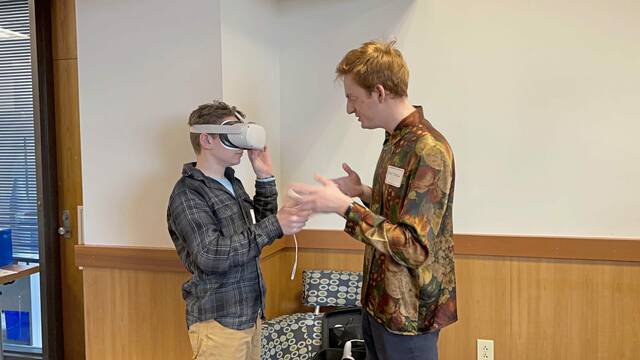https://naviga.triblive.com/local/carnegie-mellon-students-come-to-alle-kiski-valley-to-demonstrate-stem-skills-also-working-on-moon-project/
Carnegie Mellon students come to Alle-Kiski Valley to demonstrate STEM skills, also working on moon project

In just two months time, a handful of students from Carnegie Mellon University will head to the Johnson Space Center in Houston to field test the program they’ve spent months working on to assist astronauts on future missions as they explore the surface of the moon.
But on Saturday, those same students spent the morning teaching area middle school students about STEM fields, including computers and coding, and demonstrating virtual reality as part of Penn State New Kensington’s COMETS program.
“It enables kids to do so much more than browsing,” said David Lindlbauer, an assistant professor in the Human Computer Interaction Institute at CMU.
Debbie Novak, program coordinator for the Courses On Math, Engineering, Technology and Science (COMETS) at Penn State New Kensington, said she has about 35 youngsters enrolled this year. They will have eight program sessions.
COMETS initially began in 2013 as a way to introduce STEM education to girls. However, boys were invited to join in 2020, Novak said.
As part of Saturday’s program, the CMU students talked about their NASA challenge and then worked with the younger students on hands-on coding work and in demonstrating virtual reality headsets.
Alex Slabakis, a freshman at CMU majoring in art and information systems, showed the COMETS group the Little Bits coding kits they would use.
The kits include modular electronics that slip together to help teach children about coding. The process is simplistic, she said, and includes colors, videos and lesson planning.
“It’s easy and a fun way to get them interested,” Slabakis said.
Lillian Shoupe, 11, who attends Buffalo Elementary School, and Chelsea Tinnemeyer, 12, who is in seventh grade at Leechburg Middle School, worked together with the kit on Saturday.
“I like that there’s a lot of kids who are interested in this,” Lillian said.
Chelsea said she is interested in engineering and appreciated making light patterns through coding.
Xavier Kiehl, 14, is in eighth grade at Huston Middle School. As part of his experience on Saturday, he got to use the virtual reality Oculus headset that demonstrated the inside of the International Space Station.
“Turning around made me a bit dizzy,” he said.
Using the controls, he was able to explore and grab things.
Jacey Bell, who is in eighth grade at Christ Divine Teacher Catholic Academy in Aspinwall, said it was fun and realistic.
“You could move wherever. I started climbing down the walls leading down to the lab,” she said. “I like space. We don’t usually get to see the inside.”
Jasmine Fluornoy, an eighth grader at Oblock Junior High School in Plum who noticed a ketchup bottle inside the space station, said she liked being able to launch herself back and forth “inside” using the VR headset.
“I felt like I was falling because I was sinking into the floor,” she said. “It felt like when you get on a roller coaster.”
CMU student’s work with space technology
As part of Saturday’s program, the CMU students also talked about the NASA program they’re involved in.
Called NASA’s Spacesuit User Interface Technologies for Students Challenge, the team from CMU is not designing an actual spacesuit.
Instead, they are designing an app that will help astronauts on the lunar surface in three areas: navigation, geology, and emergency search and rescue.
The concept, said Joyce Zhang, a computer science and art major, is to create a “better way to display information and better way to interact with it.”
Matthew Komar, a junior at CMU, said that they have learned that it’s hard to move your arms in space, so their design will seek to limit astronauts from having to use a lot of buttons.
For the geological part of the interface, the idea is for the astronauts to be able to hold up a rock sample, and allow the interface to scan the rock, upload it and analyze it — and then decide if it ought to be collected.
For navigation, Komar said, the idea is to do hazard detection to ensure the astronauts are safe, especially in adjusting to light and darkness on the moon.
Komar said he has created his own major at CMU, which he calls immersive engineering — or the study of both virtual and augmented reality, and how to apply it for both artistic and industrial use.
“It’s a new and upcoming field so we need a new way of studying it,” Komar said.
He told the middle school students that when they get to the space center, the field tests will be performed in an environment designed to simulate the moon’s surface.
“It turns out it’s pretty expensive to put a person on the moon,” he told the COMETS group. “This stuff costs a lot of money, so we have to get it right.”
Students from several universities are participating in the challenge, including Boise State, Stanford, University of Southern California, Michigan and Virginia Tech.
Komar said that the challenge is not exactly a competition in that NASA will pull ideas from each submission and potentially blend some of them together.
Lindlbauer said his team of eight students had four months to work on the NASA program.
Copyright ©2025— Trib Total Media, LLC (TribLIVE.com)
